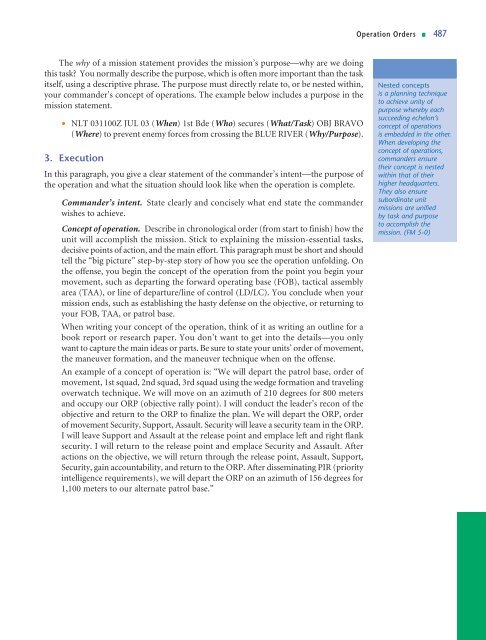Operation Orders.pdf - UNC Charlotte Army ROTC
Operation Orders.pdf - UNC Charlotte Army ROTC
Operation Orders.pdf - UNC Charlotte Army ROTC
- No tags were found...
Create successful ePaper yourself
Turn your PDF publications into a flip-book with our unique Google optimized e-Paper software.
<strong>Operation</strong> <strong>Orders</strong> n 487The why of a mission statement provides the mission’s purpose—why are we doingthis task? You normally describe the purpose, which is often more important than the taskitself, using a descriptive phrase. The purpose must directly relate to, or be nested within,your commander’s concept of operations. The example below includes a purpose in themission statement.• NLT 031100Z JUL 03 (When) 1st Bde (Who) secures (What/Task) OBJ BRAVO(Where) to prevent enemy forces from crossing the BLUE RIVER (Why/Purpose).3. ExecutionIn this paragraph, you give a clear statement of the commander’s intent—the purpose ofthe operation and what the situation should look like when the operation is complete.Commander’s intent. State clearly and concisely what end state the commanderwishes to achieve.Concept of operation. Describe in chronological order (from start to finish) how theunit will accomplish the mission. Stick to explaining the mission-essential tasks,decisive points of action, and the main effort. This paragraph must be short and shouldtell the “big picture” step-by-step story of how you see the operation unfolding. Onthe offense, you begin the concept of the operation from the point you begin yourmovement, such as departing the forward operating base (FOB), tactical assemblyarea (TAA), or line of departure/line of control (LD/LC). You conclude when yourmission ends, such as establishing the hasty defense on the objective, or returning toyour FOB, TAA, or patrol base.When writing your concept of the operation, think of it as writing an outline for abook report or research paper. You don’t want to get into the details—you onlywant to capture the main ideas or parts. Be sure to state your units’ order of movement,the maneuver formation, and the maneuver technique when on the offense.An example of a concept of operation is: “We will depart the patrol base, order ofmovement, 1st squad, 2nd squad, 3rd squad using the wedge formation and travelingoverwatch technique. We will move on an azimuth of 210 degrees for 800 metersand occupy our ORP (objective rally point). I will conduct the leader’s recon of theobjective and return to the ORP to finalize the plan. We will depart the ORP, orderof movement Security, Support, Assault. Security will leave a security team in the ORP.I will leave Support and Assault at the release point and emplace left and right flanksecurity. I will return to the release point and emplace Security and Assault. Afteractions on the objective, we will return through the release point, Assault, Support,Security, gain accountability, and return to the ORP. After disseminating PIR (priorityintelligence requirements), we will depart the ORP on an azimuth of 156 degrees for1,100 meters to our alternate patrol base.”Nested conceptsis a planning techniqueto achieve unity ofpurpose whereby eachsucceeding echelon’sconcept of operationsis embedded in the other.When developing theconcept of operations,commanders ensuretheir concept is nestedwithin that of theirhigher headquarters.They also ensuresubordinate unitmissions are unifiedby task and purposeto accomplish themission. (FM 5-0)
















